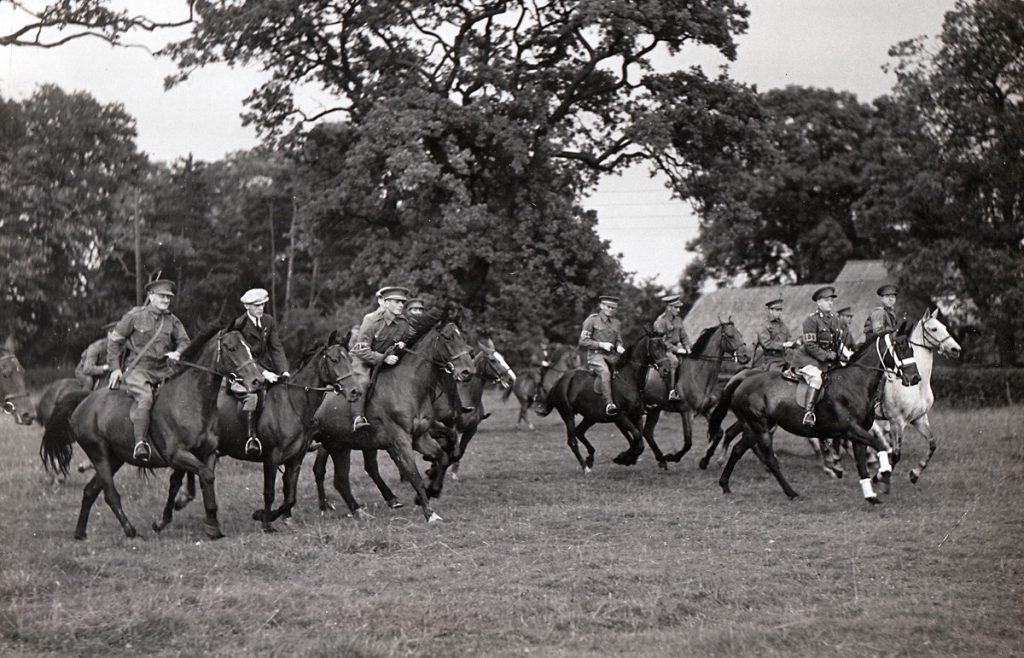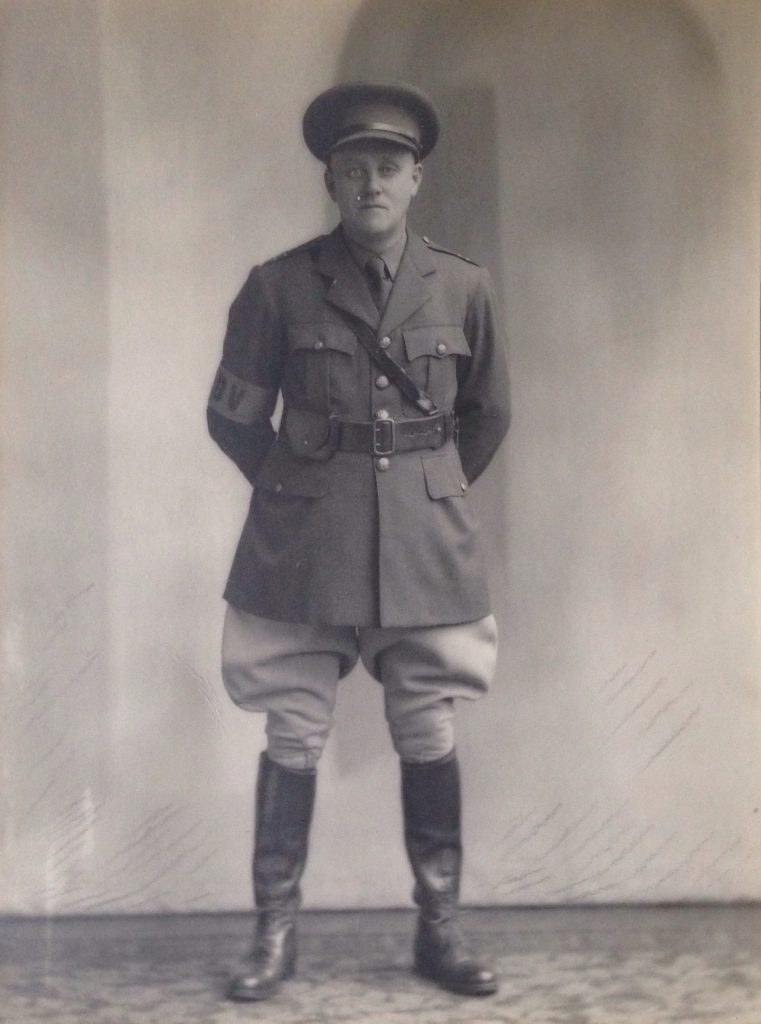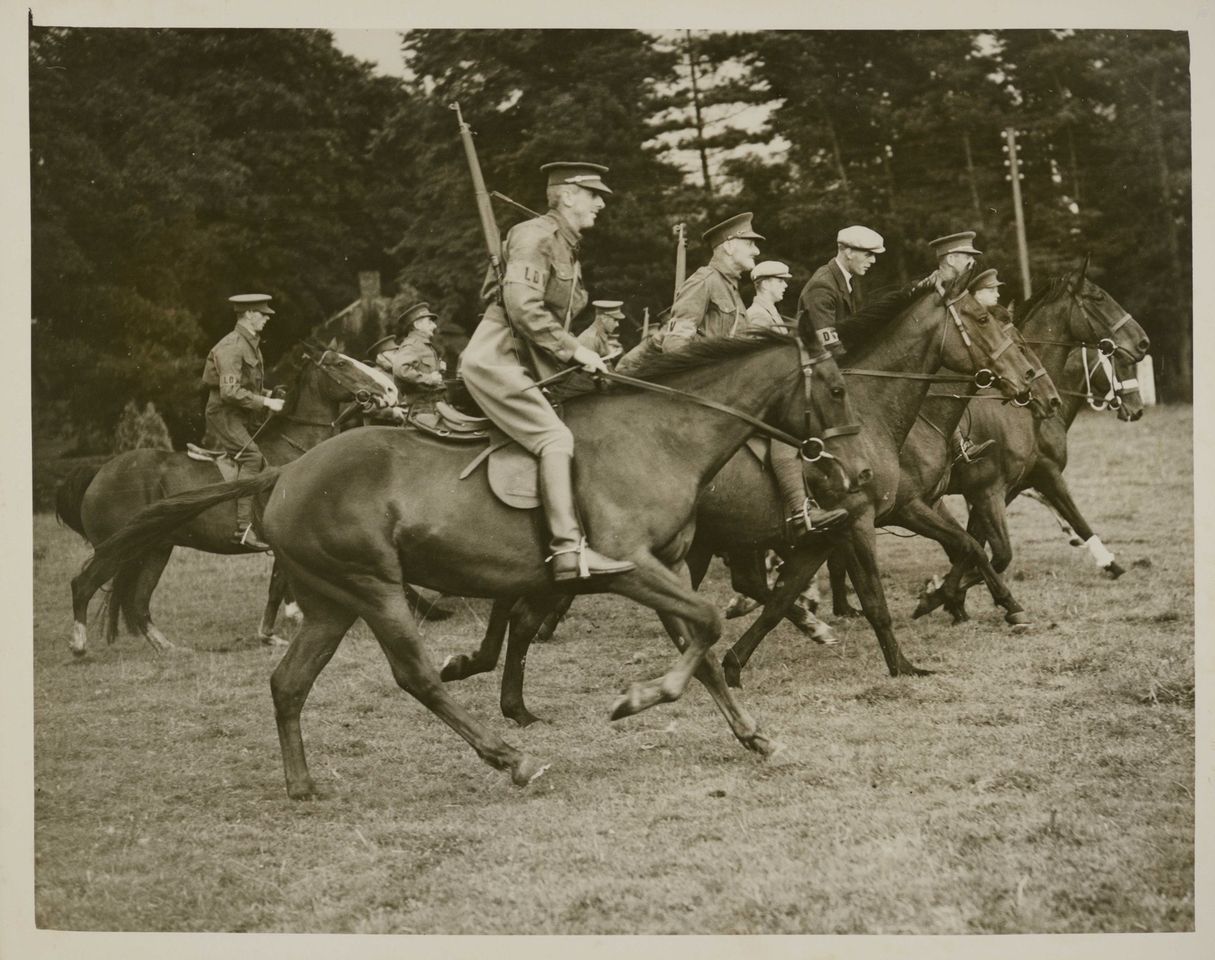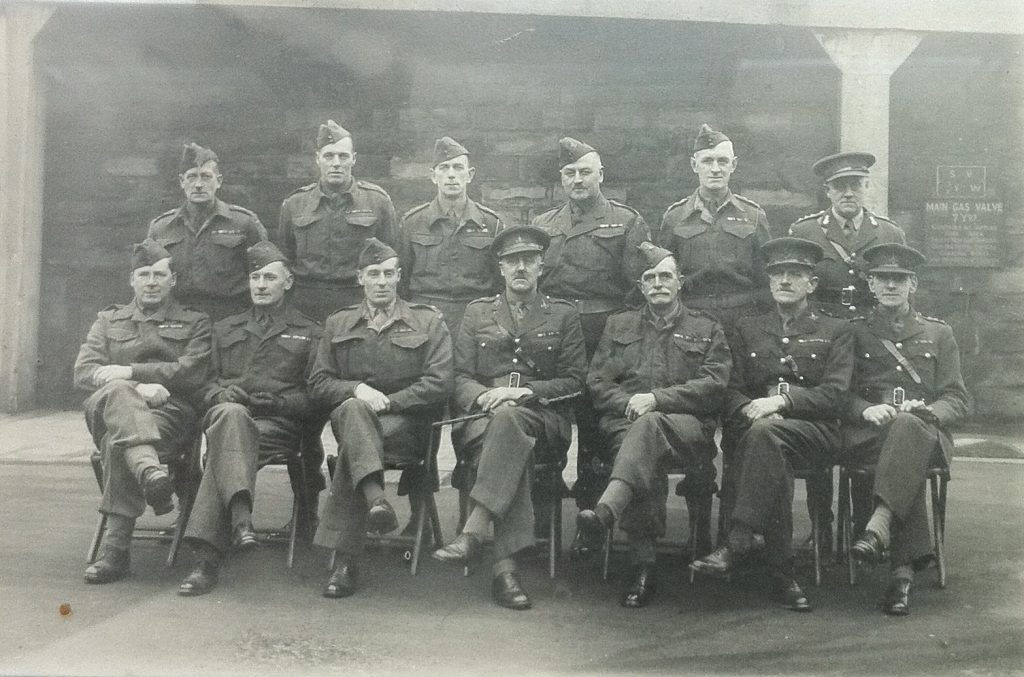William Thompson & The Mounted Home Guard

Our Great Grandfather, William THOMPSON (1891-1964), led the charge! “England’s only mounted section of the Home Guard, which nightly patrols 100 square miles of the North Riding,” read the caption in the Yorkshire Evening Press. Well, that might have been a slight exaggeration, as there were at least three other mounted units in Devon, Glamorgan, & Warwickshire.
It was the summer of 1940, the British Expeditionary Force was in full retreat and being evacuated from Dunkirk. Belgium and the Low Countries had surrendered. The Battle for France was over in less than six weeks. The news from the war was desperate – and there was a real feeling that Britain could face imminent invasion as the Battle of Britain was being fought in the skies overhead. If the Luftwaffe defeated the Royal Air Force an invasion was sure to follow.
“The Germans had just gone through Europe as though it was paper, and we genuinely thought there was a real threat of invasion.”
Noel Hetherton, The Press, 11 Nov 2013
The Local Defence Volunteers (LDV) was set up in May 1940 as Britain’s ‘last line of defence’. Secretary of State for War Anthony Eden made a broadcast calling for men aged 17-65, above or below the age of conscription and those unfit or ineligible for front line military service, to enroll in the LDV.
The government was expecting 150,000 men to volunteer. Within the first month, 750,000 men had volunteered, and by the end of July 1940, nearly 1.5 million had enrolled. At the behest of Prime Minister Winston Churchill, the name of this people’s army was changed to the more inspiring Home Guard. By the end of 1940, the Home Guard was established into 1,200 battalions, 5,000 companies and 25,000 platoons.
Members of the Home Guard still did their regular jobs and then drilled and patrolled around their work. They were not paid. In the first months it was a rag-tag militia, with scarce and often make-do uniforms and weaponry, however in the photos above and below we see a well equipped and mostly uniformed mounted unit. Almost 40% of the volunteers were veterans of the First World War, others were in reserved occupations, or teenagers awaiting call-up. Far from being the aged pensioners of Dad’s Army myth, the average age was around 35 years.
In the William’s mounted section, one of the youngest horsemen in the picture was Noel Hetherton, age 18, who would later join the Royal Navy. He recalled the troop patrolling every dawn and evening, even if not quite over 100 square miles. The evening patrols were always the most heavily attended. “You could call in at all the village pubs for a pint!” At time of the interview in 2013, he was a 91-year-old living in Green Hammerton. In 1940 the 18-year-old Cambridge undergraduate had returned to York for the summer vacation. Meanwhile another member, Mr Vause, was 70 years old and had served with Gordon at Khartoum in 1884.
Noel Hetherton’s father had partnered with William Thompson to form the mounted Home Guard. In the photograph at the top of the article, William Thompson, the troop’s captain, is second from right. Noel’s father John Hetherton, the troop’s lieutenant, is beside him on the pale grey horse.



BRITAIN’S “PARAMOUNTIES” WS/X/SR
Photo Supplied by Fox Photos Ltd, 6 Tudor Street, London, EC4. c/oWar Department, 8th August 1940
Britain now has “paramounties’ – a squadron of horse-riding parashots in the North Riding of Yorkshire. All the members are first-class horsemen and know every of the country so that in the event of an emergency and roads were blocked they could get away across country. The squadron, which acts in conjunction with the Home Guard, has as its commander, 48 year old William Thompson, former Sheriff of York. Mr. Thompson has War Office backing for the raising of this volunteer mounted troop, and hunting people generally have given their support.
Photo shows = Mounted Home Guard off on patrol.
Aug. 8th. 40. PASSED BY CENSOR. (WD 6353).
The Home Guard was formed with the intention of stalling a German invasion for as long as possible and to give the Government and the regular army time to form a front line from which the enemy invasion could be repelled. They were expected to fight highly trained, well-armed German troops using nothing but shotguns, old hunting rifles, bayonets, knives, and self-engineered pikes. Training exercises demonstrated improvised weapons such as bombs made of jam tins and ‘molotov cocktail’ petrol grenades to destroy tanks.
The mounted Home Guard took their duties seriously. There was regular weapons training with their Lee Enfield rifles at Strensall. For public (and enemy) consumption, the government maintained that large stocks of Lee-Enfield rifles remained from the First World War, but the actual stockpile amounted to 300,000, and they were earmarked for the regular army. The Home Guard were issued with castoffs and non-standard calibre weapons such as Ross rifles from Canada.
On the issue of whether civilian volunteers should actively resist German forces, even at the expense of setting themselves outside the protection of the Geneva Conventions, Churchill ruled decisively. The ‘Rules of War’ had been drawn up with the express intention of avoiding defeated combatants fighting on to the last. However, in the fight against Nazism, any outcome, including the complete destruction of a town and the massacre of its population, would be preferable to its acquiescing to Nazi rule.
There was humour a-plenty in the Home Guard but, especially in 1940, this was a “gallows humour” as the men realised all too well that their role was expected to be sacrificial as the chilling “last man, last round” order made clear.
Any discussion of how “effective” the Home Guard was must be seen in this context as few Home Guard in the invasion areas were likely to have survived the first day of invasion.
Malcom Atkin, To the Last Man: The Home Guard in War and Popular Culture, Pen And Sword Books

Standing: Capt. T Abbey, Capt. B Dawson, Capt. J O Wood, Major R Whitely, Capt. W Peat, Capt. W Thompson
Seated: Major J A Watson, Major G Ward, Major F R Widdicome, Lt/Col J Crawford (Commanding Officer), Major H Bannister, Capt. W Noon (Adjutant), Capt. E Grundy (A&O)
In peacetime William Thompson owned a grocery store in Goodramgate, York, and extended his business as an agricultural and corn merchant. He had been elected to York City Council in 1936, served as the Sheriff of York and was elected as Lord Mayor of York on November 9, 1942. As Lord Mayor he, and the Lady Mayoress, hosted the senior officers of the 6th North Riding Battalion, Home Guard, as well as many other members of the armed forces including General Montgomery aka Monty.
Post Script
The German invasion of the Soviet Union in 1941 negated the possibility of an immediate invasion of Britain. Initially, the British military did not expect Soviet resistance to last so the Home Guard needed to be in full readiness should the German threat return.
The Home Guard remained manning guard posts and performing other duties to free up regular troops for duties overseas, especially taking over the operation of coastal artillery batteries and anti-aircraft batteries. In 1942, the National Service Act allowed for compulsory enrollment in the Home Guard of men aged 42 to 51 years where units were below strength.
When the tide on the Eastern Front had definitively turned against Germany in 1943, the military necessity for the Home Guard receded. Following the successful landings in France and the drive towards Germany by the Allies, the Home Guard were formally stood down on 3 December 1944 and finally disbanded on 31 December 1945.
Family Tree
Our great grandfather, William THOMPSON, was the youngest of 7 children born to Robert THOMPSON & Elizabeth SMITH. Of his eight nephews, three served in WWII: Leading Signalman Robert Thompson, Royal Navy; Sergeant (Navigator) H Robert Thompson, Royal Canadian Air Force; & Warrant Engineer Earl D Thompson, Royal Canadian Navy.
- Robert THOMPSON (1839-1896) & Elizabeth SMITH (1849-1907)
- Mary Ellen Thompson (1876-1952)
- George R Thompson (1877-1958) & Jane A Richardson (1874-1950)
- Herbert R Thompson (1901-1921)
- Gladys M Thompson (1904-1972)
- Kathleen E Thompson (1905-1988)
- Robert Thompson (1907-?)
- Annie I Thompson (1910-?)
- Nellie Thompson (1912-1974)
- Hannah Thompson (1879-1960) & Richard W Gamble (1870-1942)
- Nellie Thompson (1900-1968)
- Mary Gamble (1904-1988)
- Lucy Gamble (1905-?)
- Hilda Gamble (1907-1988)
- Annie Gamble (1907-1988)
- Kathleen Gamble (1911-1981)
- Elizabeth Gamble (1913-?)
- Margaret Gamble (1916-1984)
- Eva Gamble (1917-1999)
- Dorothy Gamble (1922-1923)
- James Thompson (1881-?) & Emmie Simnett (1885-1989)
- Emmie Thompson (1911-1988)
- William J Thompson (1912-1995)
- Grace E Thompson (1914-2004)
- Ann E Thompson (1883-1949) & James R Richardson (1883-1958)
- Kathleen Richardson (1907-1997)
- Hazel C Richardson (1922-1997)
- Harold Thompson (1886-1960) & Myra Edith Thompson (1887-1979)
- Earl D Thompson (1914-1972)
- Margaret E Thompson (1915-2001)
- Mary E Thompson (1919-1998)
- Harold Robert Thompson (1921-1943)
- Herbert Thompson (1887-1960) & Gertrude Scott (1887-1967)
- Herbert Thompson (1911-1981)
- Harold Thompson (1913-1995)
- Robert Thompson (1918-1942)
- Gertrude Thompson (1920-2002)
- William THOMPSON (1891-1964) & Clara Eva BAKER (1893-1962)
- Winifred May THOMPSON (1920-1977) & Charles Reginald BAINBRIDGE (1915-1994)
- Our direct line…
- David William Thompson (1930-2015) & Anne J M Golledge (1939-1992)
- Winifred May THOMPSON (1920-1977) & Charles Reginald BAINBRIDGE (1915-1994)
References
- To the Last Man: The Home Guard in War & Popular Culture, Malcom Atkin, Amazon.com
- Sutton Coldfields Mounted Home Guard, The Home Guard of Great Britain
- Cowbridge Mounted Home Guard, Daily Mail, 8 Apr 2019
- 4th (Barnstaple) Battalion Devon Home Guard Mounted Squadron, Facebook
- Picture prompts Home Guard memories, The Press, 11 Nov 2013
- Yorkshire (North Riding) Home Guard, National Archives
- Home Guard (United Kingdom), Wikipedia
- Arming the British Home Guard, 1940-1944, D M Clark, Phd Thesis, Cranfield University
- Lord Mayor of York, C.O. of a mounted Home Guard unit, entertains 9th North Riding (Middlesbrough) Battalion, StaffsHomeGuard
- The Real “Dad’s Army”, Imperial War Museum
- Photographs of York and North Yorkshire during the second world war, Daily Echo, 13 Oct 2013
- Siege of Khartoum, Wikipedia
- Remember Britain’s Home Guard, Facebook






Updated article with Paramounties photograph, passed by censor, WD 6313